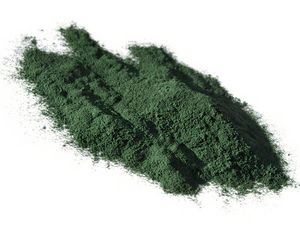Spirulina
| See Also | Food Supplements |
|---|
Spirulina is a genus of the phylum Cyanobacteria. Cyanobacteria are classified as either blue-green algae or as blue-green bacteria. Spirulina is often referred to as a so-called "green food" along with wheat grass, barley grass, and chlorella. [1]
Spirulina is coveted due to the wide range of nutrients it contains. These include proteins, chlorophyll, carotenoids, minerals, gamma-linolenic acid, and some unique pigments. These pigments contribute to its bluish colour. Spirulina is claimed to have antiviral, cholesterol lowering, antioxidant, hepatoprotective, antiallergic, and immune modulating action.[1]
Food Sources
Spirulina is a form of blue-green algae. The most common species used as food supplements are Spirulina platensis and Spirulina maxima which are harvested either from outdoor tanks or in lakes in Mexico, Central and South America, and Africa.
Uses
The following are the primary uses for spirulina: [1]
- In an animal study, spirulina exerted an inhibitory effect on the ability of herpes simplex virus type 1 from penetrating cells. In other in vitro studies, spirulina has been shown to inhibit the replication of cytomegalovirus, measles virus, mumps virus, influenza A virus, and HIV-1. Spirulina works to inhibit penetration into cells of these viruses as well. More recent research has been done using spirulina to inhibit HIV-1 replication in human T-cell lines, peripheral blood mononuclear cells, and Langerhans cells with promising results being shown with Spirulina platensis.
- Immune Modulation
- Spirulina has been shown to inhibit chemically induced anaphylactic shock and serum histamine levels in rats. In another animal study, spirulina has been shown to inhibit local allergic reactions. It has been concluded that spirulina inhibits mast-cell mediated immediate-type allergic reactions in vitro and in vivo.
- Nutrient Source: Spirulina is a source of dietary protein, B-vitamins, and iron.
Other proposed uses for spirulina include:
- weight loss
- attention deficit-hyperactivity disorder (ADHD)
- hayfever
- diabetes
- premenstrual syndrome (PMS)
- stress
- fatigue
- anxiety
- depression
- improved mental functioning
Prescribing Considerations
The recommended dosages have not yet been established. To determine what your specific requirements are talk to your naturopathic doctor or other trained medical professional.
- Spirulina can be found in a variety of "green food" supplements in the form of capsules, tablets, flakes, and powders.
- Adult: typical doses range from 250mg - 5g daily.
Safety
Spirulina is generally regarded as safe, yet spirulina and blue-green algae products are very susceptible to contaminants and the source of the spirulina or blue-green algae must be considered.[2]
- Spirulina can accumulate heavy metals such as mercury and therefore only reputable sources should be used.
- Contaminated blue-green algae can cause liver damage, stomach pain, nausea, vomiting, weakness, thirst, rapid heartbeat, shock, and death. Don’t use any blue-green algae product that hasn’t been tested and found free of mycrocystins and other contamination.
- Gastrointestinal symptoms such as nausea and allergic reactions can occur, yet they are rare.
- Children: Spirulina is not recommended for children or adolescents.
- Pregnancy and Breastfeeding
- Spirulina should be avoided during this time as there are not sufficient studies to determine its safety and because the risk associated with contaminated spirulina is too high.
- Contraindications
- hypersensitivity to any component of spirulina
- Precautions
- Spirulina can accumulate heavy metals such as mercury and therefore only reputable sources should be used.
- Auto-immune diseases such as multiple sclerosis (MS), lupus (systemic lupus erythematosus, SLE), rheumatoid arthritis (RA), pemphigus vulgaris (a skin condition), and others.
- Blue-green algae might cause the immune system to become more active, and this could increase the symptoms of auto-immune diseases.
- Phenylketonuria: The spirulina species of blue-green algae contains the chemical phenylalanine. This might make phenylketonuria worse.
- Drug Interactions:
- Medications that decrease the immune system (Immunosuppressants): By increasing the immune system, blue-green algae might decrease the effectiveness of medications that decrease the immune system.
- Some medications that decrease the immune system include azathioprine (Imuran), basiliximab (Simulect), cyclosporine (Neoral, Sandimmune), daclizumab (Zenapax), muromonab-CD3 (OKT3, Orthoclone OKT3), mycophenolate (CellCept), tacrolimus (FK506, Prograf), sirolimus (Rapamune), prednisone (Deltasone, Orasone), corticosteroids (glucocorticoids), and others.
- Nutrient Interactions
- No known interactions
References
- ↑ 1.0 1.1 1.2 Hendler Sheldon, Rorvik David (Editors) (2001) PDR for Nutritional Supplements, Medical Economics Company Inc.
- ↑ http://www.nlm.nih.gov/medlineplus/druginfo/natural/923.html
